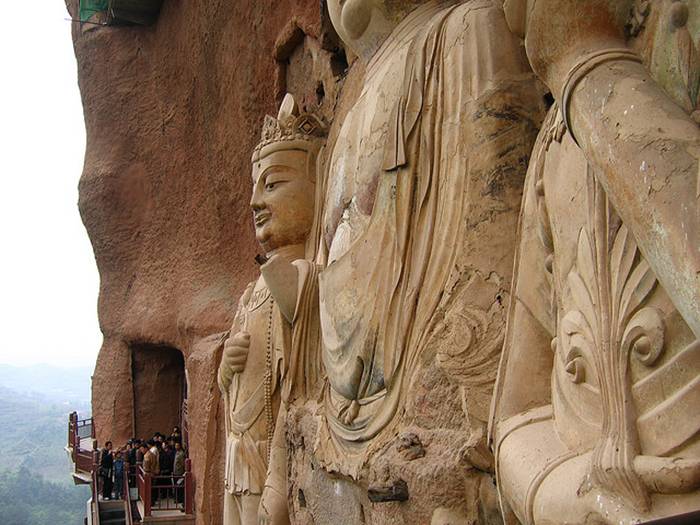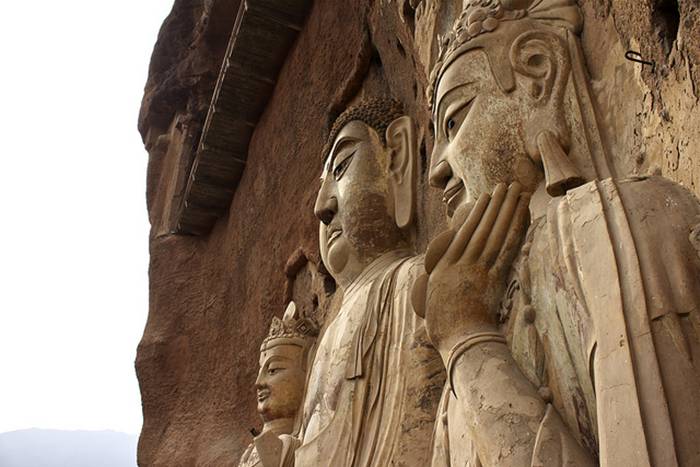07/28/13
Filed under:
General
Posted by:
site admin @ 4:56 pm
994 LESSON 29-07-2013 MONDAY
FREE ONLINE eNālāndā Research and Practice UNIVERSITY
run through http://sarvajan.ambedkar.org
Universal Welfare Friend -
E- GOOD NEWS
DISPENSATION OF AWAKENED ONES WITH AWARENESS is for DUKKHA NIRODHA (End of Suffering) of all SENTIENT & NON-SENTIENT BEINGS
(5) the age of generosity (dana-yuga)
http://in-mg61.mail.yahoo.com/neo/launch?.rand=9a6qnbm2od815#mail
Simpsons creator is spending his last months giving away his fortune before dying of colon cancer.
The producer of The Simpsons has decided to give his vast fortune away before he dies from colon cancer.
Sam
Simon, 58, is spending his final months funding projects that feed
homeless people and save animals from being killed in animal shelters.
‘The
truth is, I have more money than I’m interested in spending. Everyone
in my family is taken care of. And I enjoy this,’ Simon explained.
Simon created the hit cartoon
alongside Matt Groening in 1991 technically retired from The Simpsons in
1993 but still receives tens of millions in royalties every season.
Simon
has set up a food bank in Los Angeles that serves only cruelty-free
vegan food, and turned his Malibu mansion into dog rescue where animals
who are about to be put down by local shelters are taken, cared for, and
then trained to be companions for the deaf.


Frozen Lemon Cure Cancer, Read []
HEALTH INFO !!!
Frozen Lemon - A Cure for Everything? Literally, yes everything…..almost.
Amazing frozen lemons
All it is…..is a frozen lemon
Many professionals in restaurants and eateries are using or consuming
the entire lemon and nothing is wasted. How can you use the whole lemon
without waste?
Simple.. place the washed lemon in the freezer section of your
refrigerator. Once the lemon is frozen, get your grater, and shred the
whole lemon (no need to peel it) and sprinkle it on top of your foods.
WHERE TO SPRINKLE ?
Sprinkle
it to your vegetable salad, ice cream, soup, cereals, noodles,
spaghetti sauce, rice, sushi, fish dishes, whisky…. the list is
endless.
All
of the foods will unexpectedly have a wonderful taste, something that
you may have never tasted before. Most likely, you only think of lemon
juice and vitamin C. Not anymore.
Now that you’ve learned this lemon secret, you can use lemon even in instant cup noodles.
What’s the major advantage of using the whole lemon other than preventing waste and adding new taste to your dishes?
WHAT MAJOR ADVANTAGE YOU HAVE BEEN MISSING ?
Well,
you see lemon peels contain as much as 5 to 10 times more vitamins than
the lemon juice itself. And yes, that’s what you’ve been wasting.
But
from now on, by following this simple procedure of freezing the whole
lemon, then grating it on top of your dishes, you can consume all of
those nutrients and get even healthier.
WHAT DOES THE LEMON PEELS DO IN YOUR BODY ?
It’s also good that lemon peels are health rejuvenators in eradicating toxic elements in the body.
So place your washed lemon in your freezer, and then grate it on your
meal every day. It is a key to make your foods tastier and you get to
live healthier and longer! That’s the lemon secret! Better late than
never, right? The surprising benefits of lemon!
Lemon (Citrus) is a miraculous product to kill cancer cells. It is much, much stronger than chemotherapy
Why
do we not know about that? Because there are laboratories interested in
making a synthetic version that will bring them huge profits.
You
can now help a friend in need by letting him/her know that lemon juice
is beneficial in preventing the disease. Its taste is pleasant and it
does not produce the horrific effects of chemotherapy.
How
many people will die while this closely guarded secret is kept, so as
not to jeopardize the beneficial multimillionaires large corporations?
You
can eat the fruit in different ways: you can eat the pulp, juice press,
prepare drinks, sorbets, pastries, etc… It is credited with many
virtues, but the most interesting is the effect it produces on cysts and
tumours.
This
plant is a proven remedy against cancers of all types. Some say it is
very useful in all variants of cancer. It is considered also as an anti
microbial spectrum against bacterial infections and fungi, effective
against internal parasites and worms, it regulates blood pressure which
is too high and an antidepressant, combats stress and nervous disorders. The
source of this information is fascinating: it comes from one of the
largest drug manufacturers in the world, says that after more than 20
laboratory tests since 1970, the extracts revealed that It destroys the
malignant cells in 12 cancers, including colon, breast, prostate, lung
and pancreas…
The compounds of this tree showed 10,000 times better than the product
Adriamycin, a drug normally used chemotherapeutic in the world, slowing
the growth of cancer cells.
And what is even more astonishing: this type of therapy with lemon
extract only destroys malignant cancer cells and it does not affect
healthy cells.
So, give those lemons a good wash, freeze them and grate them. Your whole body will love you for it!!!!!
Live simply, Love generously, Care deeply, Speak kindly.
– THERE ARE NO STRANGERS, ONLY FRIENDS YOU HAVEN’T MET!!
it is turly “INCREDIBLE”.
Absolutely amazing! How did they build and carve on a mountain face ?
Maytszishan Caves — China
Buddhist
complex Maytszishan little known. It is located in Gansu Province in
northwest China. This is a striking architectural complex, carved out of
the rock. Maytszishan has 7,000 Buddhist sculptures and nearly 1,000
square meters of murals. 11 more images …
Maytszishan is just a few miles south of the Great Silk Road. Many of the monks chose to stay in these caves and work there.
One
of the earliest written records about this are found in the biographies
of the two monks Tanhonga and Huanggang, who meditated there with his
disciples.
Huge
Buddha is almost parallel to the side of the mountain - the highest is
more than 16 meters in height. Stairs that lead up and around the caves
were originally made of wood, but after been fitted with metal supports,
for security purposes.
(5) the age of generosity (dana-yuga)
http://movedbylove.servicespace.org/blog/?gclid=CKrsqPGk07gCFYgB4godty0A5w
http://www.ayogisway.com/dharma/article-dana-generosity/
Spirit Rock Meditation Center’s Dharma Hall - Woodacre, CA (Acquired solely via Community Dana)
Perhaps you’ve
already heard the murmurs about donation-based classes in your yoga
community. If you’re a practitioner of Buddhist
meditation then you’ve most certainly been exposed to the practice
of generosity as one of Buddhism’s paramitas, or perfections. In this
post I will give a brief overview and description of
the what and why of donation-based offerings.
Traditionally in
Asia all teachings have been offered in an ‘open-handed’ manner. That
is, they are offered free of charge, and in a way
that makes the teachings equally accessible to all who desire to
learn and grow from them. This way of offering teachings is done purely
from a place of generosity, with no expectation of
reciprocal exchange of any kind. The benefits of making practices
available to all is quite obvious; it is the natural extension of having
benefited from them ourselves.
All that we need to
do to truly see when teachings are not being offered ‘freely’, is to
take a glance around at the participants in the next
class we attend - does the community consist solely of middle-aged
participants of European descent? Nothing ultimately wrong with this
per se; but to yoke our practice with the vision of a
world that is inclusively free, is to take the next step in helping
to create freedom for as many as possible. And simply put, this is the
result of offering teachings by donation.
If we pause here to
reflect on what drives most of our daily life, we immediately notice
that most of our action are done in the hopes of causing
certain results. Not only that, but the consumer culture we live in
is based upon the ‘law of exchange’; money for things and services,
favors for praise and friendship, etc. The fact
that our world is entrenched with exchange may sound familiar, as
this is also the basic description of samsara, or the cyclic existence
that mindful practice hopes to liberate us from.
Exchange is in the very fiber of how we live, and often to even
consider a ’system’ that does not include exchange, can be next to
impossible. Money is not ‘bad’, but only serves its
purpose at a certain ‘level’, or frequency of living.
Basically the
donation-based system of offering classes is ‘pay at a level that is
appropriate for you’. What is appropriate? This is
where the donation-based offerings truly shine, as now the student
is brought to a more full relationship with the concepts of value,
generosity, and support. Hmmm… Based on my
income, what the practice means to me, how I believe the practice
should be made accessible, etc, an amount is then decided upon. This is
not a payment for the class, but rather an
opportunity to be generous.
Some people will
have the means to give more, some less. Again, the means is not just a
big bank account, but includes things like feeling
that one has enough to give. We’ve all known some financially
wealthy people who consistently thought they were ‘broke’; and we
probably have also known someone who has very little
financial resources, but always seem to have plenty to share. The
practice of generosity allows us all to learn how to ’stretch’ our
hearts a little bit at a time.
This may sound like
playing with semantics; I assure you it is not. The teachings are
given freely… done. No donation is required,
but if the student so chooses, then they can support the propagation
of the teachings via supporting the specific teacher. At first when
this new practice is offered, a student may feel
obligated to give; thinking, ‘I know its donation-based, but I’m
sure they expect me to give the going rate’; but as the student’s
relationship to generosity matures, they then can most clearly
begin to feel the benefits of being generous. The Buddha said, ‘If
you knew what I do about generosity, you wouldn’t allow a single meal to
pass without sharing it’. It is true,
generosity feels so very good - so natural.
Conversely, I have
been to donation-based classes that were so very close to offering
teachings freely, but when it came down to it they really
weren’t offering them in an ‘open-handed’ manner. There was a bit
of ‘but offer a little bit more… please’ energy. This completely
undermines the initial act of generosity, as it
says to the student, ‘thank you, but your generosity isn’t quite
enough’. A person’s ability and means to be generous is what it is, and
no one can access that for another - that is the
beauty of donation-based offerings; each student makes a practice of
extending their heart, a relationship that grows over a lifetime.
Because
donation-based offerings and generosity are ‘outside’ of cause and
effect, they then exist also outside of time. An act of
generosity can have immense impact, both on the recipient, but also
on the giver (and it doesn’t need to be money - that’s for sure).
Generosity is an affirmation of abundance; it is an
expression from the wellspring that is each person’s true nature.
Have you ever known anyone who seemed to seldom be generous - with
their time, their resources, or else-wise? How do
you think that person experiences the world? Do you think it is a
happy and expansive experience? Most likely not. The practice of
generosity actively cultivates the freedom
that each heart longs for.
As a practice, I
recommend doing something generous for anyone - it can be someone you
know or someone you do not know. When performing the
act, check in with your intention. Notice closely if you have any
agenda or desire to be ‘noticed’ or ‘rewarded’ for your act. To truly
act from generosity is to be free to act in the
way nature intended for you. You’ll feel it when you are in line
with the truth of who you are. Enjoy this practice, and the discovery
of your truest expressions.
http://www.elephantjournal.com/2013/01/dana-generosity-barry-h-gillespie/
Dana: Generosity. ~ Barry H. Gillespie

Give freely and receive graciously.
Dana is the first of the 10 paramis, the “perfections,” that Theravaden Buddhism encourages us to practice.
Whenever the Buddha taught, especially to lay people, the first thing he taught was Dana.
Why did he do that?
There are two principal reasons. The first is that everyone, no
matter their level of education or intelligence or physical ability, can
practice generosity. The second is that Dana is a direct
antidote to grasping, the cause of suffering. When you grasp something
your hand has to close around it. When you are being generous, when you
are offering something, your hand has to open and let go.
In our culture we are encouraged to define ourselves by what we
possess: the cool car, the nice house, the good job, the latest
electronic gizmo. All these things are “mine.” Thinking in this way we
create a sense of separateness, of me and not me. Our self-image is
propped up by owning these things. They help us define who we are: our
status, our rank in society relative to others.
I had a student once who wore a t-shirt that said, “The person with
the most toys when they die wins.” That pretty well sums up our culture.
Generosity allows us to start thinking of our possessions,
of the things we use to carry on our daily lives, not so much as “mine”
and more as “just stuff.” We have this thing now because we need it.
When we no longer need it, or someone needs it more, we can simply let the user of the object change.
I don’t need to cling to anything. Generosity not only breaks down our
sense of a separate self, it helps us connect to the needs and suffering
of others, to feel more connected to everyone else. Generosity
increases our ability to experience compassion.
Generosity is what Buddhists call a wholesome mind state.
The more often our mind is in a wholesome state, the less often we
get dragged down by being in an unwholesome mind state like greed. It is
also a long lasting mind state. We feel it when we contemplate the act
of giving, we feel it as we actually give something and we feel it
afterwards, reflecting on our act of generosity.
This does not mean we should fill ourselves with feelings of
self-importance. Giving just becomes a natural act. We become one with
the flow of stuff. Nothing special. We need to be careful not to start
thinking that we are somehow better than the one we are giving to. This
simply takes us back to the mind state of us and them.
We need to give whatever we give gladly,
without regret and with no need for praise. The quality of our feelings
as we give affects the process, and the receiver. There is a great
story from the Buddha’s time that illustrates this.
All of the bikhus, the monastic students of the Buddha,
had gathered together for the rains retreat, a three month period when
they didn’t travel but instead stayed with the Buddha and practiced.
Part of the discipline of the monks was that they couldn’t grow food,
store food or handle money. They were totally dependent on the
generosity of the nearby lay people for their daily meal. A famous lay
disciple of the Buddha, a wealthy merchant, gladly fed 500 of them every
day. When the local king heard about this he decided he couldn’t be out
done, and ordered his cooks and servants to prepare a big feast every
day and feed another 500 monks. The monks would come, but never eat the
food in his presence. The king got curious, wondering why he never saw
them eat the food. What he found out was that the monks would take the
food, give it to other lay disciples, who would then immediately give it
back to them, but without any attitude of self-importance. Then the
monks could eat it.
Another aspect of generous acts we should always keep in mind lettomg
other people give to us. Let them experience the joy of giving. Often
when someone offers us something, especially if it is something we don’t
particularly need or perhaps even like, or if we feel that they really
can’t afford to give, we politely (or so we think) decline. This is very
ungenerous of us. It breaks the cycle of generosity. It reinforces our
own sense of superiority. Just take whatever is offered. You can always
pass it on again to someone else later.
Generosity doesn’t have to mean giving material things or money. In
fact, often the most generous thing we can give in our busy world is our
time. There are so many things that need doing that we can do
voluntarily. We just look around us and see all the suffering there is
in the world and then step in and help out where our help is needed.
How does generosity relate to our more formal meditation practice?
Choosing to sit with others, to be part of a sangha, is a
very generous act. People regularly sitting together reinforce each
other. If we are having a low energy day the knowledge and the feeling
of all those other people sitting around us lifts us up and helps keep
us going. Then the next time we sit, we may be full of energy and
concentration, helping others who may be struggling.
Generosity is easy to practice. We just need to consciously take the
many opportunities to be generous that present themselves every day. As
we deepen our generosity we will break down our need to grasp and our
sense of separation from others. We’ll become more like a Buddha.
 Barry H. Gillespie
Barry H. Gillespie
was introduced to formal meditation practice in 1978, through the
Sivananda Yoga Vedanta Ashram. In 2003 he began exploring Theravaden
Buddhist practice, sitting many long retreats at the Insight Meditation
Society in Barre, MA and Spirit Rock in Woodacre, CA. His principle
teacher is Guy Armstrong. His teaching arises out of his desire to share
what he has learned with others. Barry currently leads the Full Moon
Sit at the Yoga Workshop in Boulder, CO. This article is based on a
dharma talk he gave there. For more information on his teaching go to
his website.
http://www.spiritrock.org/page.aspx?pid=298




Dana - The Practice of Generosity
Dana (pronounced “dah-na”) is a Pali word meaning generosity. Dating
back to the time of the Buddha, there has existed an interdependence
between those who offer the teachings and those who receive them. The
teachings are given freely, since they are considered priceless.
Registration fees for retreats cover food, rental, transportation, and
other Spirit Rock expenses. None of this money goes directly to the
teachers or residential retreat staff. Classes and daylongs are also
held on a donation basis. To allow the teachers and residential retreat
staff to continue their dharma work, support from the students is
needed. There will be an opportunity to contribute at the end of each
retreat, class and daylong.
In addition, the development of
Spirit Rock as a retreat center has been funded almost entirely by
donations from individuals. The completion of the planned developments
will depend on the continued generosity of committed supporters. Your
support of both the Center and the Spirit Rock teachers will allow the
Center to flourish and others to benefit from the teachings.
According
to the Buddha, generosity, or sharing what we have, is one of the
central pillars of a spiritual life. In the act of giving we develop our
ability to let go, cultivate a spirit of caring, and acknowledge the
inter-connectedness that we all share. The Buddha created a system to
develop this quality of open-handedness whereby those who share the
teachings are dependent on those who receive them. Monks and nuns go on
daily alms rounds with a begging bowl, relying on the generosity of lay
people for support in continuing their teaching and spiritual life.
It
is the practice of dana that has kept the Buddhist tradition alive for
more than 2,500 years in Asia, where committed supporters have given
generously to establish networks of monasteries and retreat centers
providing for millions of teachers and practitioners. As this ancient
teaching moves to the West, we hope to keep alive this joyful tradition.

The Effective Sweet Treat that Relieves Arthritis Pain
This may help us with pains & it is enjoyable too
This is the best e-mail I have received, I tell you why.
Some of you know that I have osteoarthritis stabalised by
knee exercises and Glucosamine and Condrontin for the
last 8 years while a few of my peers had knee replacement
during this time.
Last November I went to Hanoi Bay and did quite a bit of
climbing that aggravated the pain in my right knee and
started the pain in the left. Still I persisted with my
medication and knee exercises. It gave relieve up to 70%.
One of my favourite fruits is pineapple. I realize that for
weeks since my trip to Hanoi I have not eaten any pineapple.
I really missed that so went out to purchase one.
Walloped one big piece heartily. Lo and behold, next morning
when I started my exercises, the pain was nearly gone.
There was around 95% relieve. Thinking it was the benefit
of the exercises I increased the momentum another 5 to 10
minutes.
Later in the day I began to think how could the pain decrease
so much overnight. Aha. only difference was the pineapple
that I ate. Yes you guessed it, I went and walloped some more
and obtained more relieve . Back to before I went to Hanoi Bay.
Happy but too shy to tell anyone until my sister rang up to inform
of
her back ache and unable to stand straight. Rebuked her for not doing
anything like rubbing ointment or seeing a Dr. Jokingly informed her of
my pineapple experience. Laughingly she said
she was going to try that. A
week or so later she came over and proudly showed me that she could
walk straight without any pain.
With thumb up she informed that the pineapple worked.
So friends if you or anyone you know have arthritis pain, pineapple
is worth the try. I dare to inform you after receiving this e-mail.
* The Effective Sweet Treat that Relieves Arthritis Pain*
By Jim Healthy On October 19th, 2012
Did you know that there are certain kinds of foods that actually help
reduce or even stop arthritis pain?
These “superfoods” are usually easy to find and inexpensive.
Of all the foods that help fight against arthritis — delicious, sweet
pineapple comes up close to the top of the list.
*THE SWEET PAIN RELIEVER
For generations, people around the world have used fresh pineapple to ease their arthritis inflammation.
Loaded with joint-protecting vitamin C, pineapple is undoubtedly a superior arthritis-healing food.
Its anti-inflammatory ingredient — bromelain — is so potent that many
boxers drink the juice after fights to heal their bruises.
A 1960 study compared boxers who took bromelain with those receiving a placebo. In just four
days, an amazing 78% of those
taking bromelain were inflammation-free, while only 14% of the control group had recovered.
Other than bromelain, pineapple also contains manganese, which
bones and protects joints.
Here are 5 reasons you should be indulging in this delicious fruit if you struggle with joint pain and arthritis:
*Reason #1: Joint Protection*
Higher
intake levels of the antioxidant vitamin C is essential for
people with arthritis…And just one cup of pineapple has a whopping
94% of the recommended daily allowance (RDA)!
Research published in the Annals of the Rheumatic Diseases showed
that vitamin C-rich foods protect against inflammatory polyarthritis,
a type of rheumatoid arthritis in which two or more joints are affected.
If you have osteoarthritis,
you may be concerned by warnings that you should not increase your
vitamin C intake. But know that those warnings are based on a 2004
study on guinea pigs!
Studies on humans show vitamin C actually reduces pain, cartilage loss and disease progression.
*Reason #2: Healthier Joint Tissue*
Pineapple is a great source of the trace mineral manganese.
Manganese is absolutely essential for building healthy joint tissue
and dense bones. One cup of pineapple provides 128% of the RDA
for manganese.
Research shows that manganese tackles free radicals that can damage joint cartilage.
Tip: It’s best to eat your pineapple raw. Fruit skewers alternating fresh
pineapple chunks with strawberries is a great way to do that. Grilled and cooked pineapple is extraordinarily tasty too.
*Reason #3: Smoother Joint Movement*
Pineapple’s enzymes literally clean up “rusty” joints. When you eat
pineapple on an empty stomach, the enzymes go right to work on your joints.
Tip: If you eat pineapple with other foods, the enzymes divert their
activity to digesting the rest of your meal instead of the gunk in your
joints.
So
keep pineapple around for between-meal snacks. Juice the hard inner
core as well to take advantage of the concentrated bromelain
located there.
*#4: Pain Relief*
For optimal arthritis pain-relief, eat fresh pineapple. The bromelain in
pineapple is destroyed by heat, so fresh pineapple will give you the most benefit.
Frozen pineapple retains active enzymes, but canned fruit and
commercially processed juice don’t provide the anti-inflammatory
benefit of fresh fruit.
It’s important to note bromelain causes anti-clotting activity…
So you should consult with your physician before combining pineapple
with blood-thinning medications such as warfarin (Coumadin), heparin,
or aspirin.
Tip: If the fruit needs to ripen, keep it on your kitchen counter for a
couple days. You’ll know it’s sweet and ready to eat when the bottom
softens a bit.
*Reason #5: Protection
from Inflammation*
Pineapple’s bromelain halts
inflammation. The sulfur-based enzyme bromelain in fresh pineapple is
one of the best-researched natural anti-inflammatory agents around.
Bromelain clobbers inflammatory agents that trigger joint pain and
cartilage degeneration.
A 2006 study cited in Clinical and
Experimental Rheumatology found that supplemental bromelain is
effective in easing discomfort from
hip arthritis.
The
Arthritis Foundation stated that pineapple’s bromelain produces
effects comparable to NSAIDs for relieving pain and inflammation.
UK
researchers reviewed ten studies on osteoarthritis and bromelain.
They found that every single one confirmed bromelain’s benefits.
Tip: Most of the bromelain in pineapples is found in the core and the stem.
So don’t throw away that tough, fibrous core!
Just chop it up, throw it in a blender with some water and pulse to convert it to juice.
http://seattletimes.com/html/health/2021488329_indiasurrogatesxml.html

In India, a rise in surrogate births for West
A new survey paid for by India’s government
said that in the absence of regulation, unscrupulous agents are luring
poor, uneducated women into signing surrogacy contracts that they do not
fully understand.
By Rama Lakshmi
The Washington Post
SAM PANTHAKY / AFP/ Getty Images, 2011
Dr. Nayna Patel, a pioneer of reproductive
surrogacy in India, conducts an ultrasound on a 30-year-old surrogate
in Anand. A new government-funded survey says unscrupulous agents are
luring poor, uneducated women into surrogacy contracts.
NEW DELHI — When Komal Kapoor, 24, handed over the twins she
had just borne to a visiting American couple last month, she said she
felt “something like sadness.”
But that lasted just a few minutes.
“In my head I kept saying, ‘These are not my children, these are not
my children,’ ” recalled Kapoor, a surrogate mother who lives in a New
Delhi slum. After delivering what she called two “very beautiful,
fair-skinned, black-haired babies” for the couple, she signed a document
relinquishing all rights to the infants in return for about $8,000,
more than 12 times her annual earnings as a garment worker. “With the
money, I want to secure my daughter’s future,” she said.
This nation of more than 1.2 billion people has emerged as the
preferred destination for a growing number of couples from around the
world who are looking for a low-cost, trouble-free way of becoming
parents. But a government-funded survey released this month said that in
the absence of regulation, some unscrupulous agents are luring poor,
uneducated women into signing surrogacy contracts that they do not fully
understand.
While there are few statistics on the surrogacy industry in India,
the country has become a hub for medical tourism because of the
availability of advanced technology, the large number of medical
professionals and the relatively cheap costs.
“All this, coupled with the huge number of poor women and lack of
legal scrutiny, has ensured the commercial-surrogacy boom,” said Manasi
Mishra, co-author of the survey.
She said many other developing countries either do not allow commercial surrogacy or have few sophisticated hospitals.
Many of the women in her study were bearing babies for couples in the
United States and Britain. The report said some couples used Skype to
periodically view the surrogate mother’s belly to monitor the progress
of the pregnancy. U.S. couples would pay five or six times as much for a
surrogate pregnancy in their own country as they do in India, according
to doctors and industry officials in India.
The new survey, done by the women’s advocacy group Center for Social
Research, said there is “no fixed rule” for payments to surrogate
mothers and are “arbitrarily decided by the clinics.” The women, the
report said, are kept in special, guarded facilities and allowed limited
social interaction during pregnancy. The rights of women who miscarry
are not secured, it said.
Roots of boom
Doctors, activists and agents say the surrogacy boom began with
infertile Indian-origin couples in countries such as the United States,
Britain and the United Arab Emirates seeking out women in India to bear
their children. At least half of the clients still belong to that group,
Mishra said.
In most cases, the clients’ sperm and egg are implanted in the
surrogate’s womb, with DNA tests done after the birth to prove the
genetic links to the couple and ease the issuing of a foreign passport.
Doctors say the practice is growing among Indians, too. This month,
one of Bollywood’s biggest stars, Shahrukh Khan, said his newborn had
been carried by a surrogate, bringing social respectability and some
trendiness to the practice. But the cost remains prohibitive in a
country where a majority live on less than $2 a day.
“India is becoming a popular destination in the search for surrogate
mothers, agencies are mushrooming, and now Bollywood stars are also
giving the whole practice a stamp of social legitimacy. But it is
frightening that all this is happening in a legal vacuum and without any
monitoring,” said Ranjana Kumari, director of the Center for Social
Research, based in New Delhi.
“Middlemen bring poor, uneducated women from the hinterland or from
city slums with the lure of money. All this is being done under the
facade of a noble cause of helping childless couples and supporting poor
families.”
The group interviewed a total of 100 surrogate mothers in New Delhi
and Mumbai for its survey. Most surrogates were married and had at least
one child. About half of the respondents said they had finished primary
school; slightly more than half said they worked as housemaids, earning
an average of about $50 a month.
The majority mentioned either poverty or their children’s education
expenses as the reasons for agreeing to carry others’ children. Most
women told interviewers that it was their decision to be surrogates, but
sometimes they were also pressured by their husbands to earn money.
The India Council of Medical Research, a government body, introduced
guidelines for accreditation, supervision and regulation of surrogacy
and assisted-reproduction clinics in 2005. Later, the government
formulated draft legislation that incorporates these guidelines, but the
bill hasn’t been introduced in Parliament. Activists, doctors and
surrogacy agencies are urging lawmakers to pass it quickly. But Kumari
said the measure needs stricter punishments for violations.
Promoters of practice
While there are no firm statistics, the new report estimates the surrogacy industry is worth more than $450 million a year.
Many in the business defend it as helping infertile couples and
low-income Indian women. Promoters say the surrogacy agreements mandate
that the women stay in special shelters during their pregnancies because
the facilities are cleaner than their impoverished neighborhoods and
the women’s health and nutrition can be monitored.
“Let us not forget that there are two women involved in this
process,” said Hrishikesh Rai, a gynecologist and president-elect of the
Indian Society of Assisted Reproduction in Mumbai. “It is not an easy
or casual decision for the infertile couple either. Surrogacy is the
last extreme and a very difficult decision for couples. “
“The surrogate mothers come from very poor families, but they gain
money and also self-confidence,” said Jagatjeet Singh, director of Wyzax
Surrogacy Consultants in New Delhi. “They have a bank account in their
names, health-insurance card; they are exposed to clean, hygienic living
during this period. Their aspirations for their own children begin to
take shape.”
Singh added that women come to his agency saying: “ ‘Please enroll
me, please enroll me.’ We do not even need to persuade them much now.”
Kapoor said she heard about surrogacy from a neighbor who volunteered
at the agency. Kapoor normally earns $54 a month gluing glitter on
T-shirts, while her husband, who sorts and sells garbage, brings home
about $85 a month.
She said she persuaded her husband to go along with the surrogate
pregnancy but did not tell her parents. She left her home for nine
months to live in the surrogate shelter with her 4-year-old daughter.
Her husband visited occasionally.
In June, when the U.S. couple met with Kapoor to take the twins,
there was not much conversation. “They kept saying, ‘Thank you, thank
you,’ the whole time,” she recalled.
In the survey, there was a question about whether the surrogate
mothers experience any doubt or difficulty about handing over the baby
to the commissioning parents. A majority chose not to reply.
As
you know, Google - is not only a search engine: The company is a world
leader in gadget creation,internet services, smartphone apps and more.
The most curious development is the secret Google X; among X projects -
airships that distribute wireless Internet, but this is just the tip of
the iceberg, here are 10 ideas that the Internet giant seeks to bring to
life in the near future.

Driverless Car
Negotiations
are underway with the authorities for permission to test the
self-governing vehicles on public roads, but only in California and
Nevada.

Google Glass will change the way you think about gadgets
Having
put on those glasses, you can forget about the screens of smartphones
and computers - the right information will always be available in only
one eye movements.
Calendar, email, social networks, weather, everything that you might want to know on the go.
Google
Glass makes a revolutionary technology available to a wide range of
people so far only a few lucky people, mostly developers and journalists
were able to get a working prototype, but the consumers may get
their hands on one as soon as 2014.

“Smart Home” from Google
The
technology, called Android @ Home, will fully automate all of the life
support system by connecting to the Internet, for example, while you are
not home, a refrigerator will be able to order the necessary products
itself, and coffee maker will make coffee exactly for your arrival.
You might say this is crazy but apparently Bill Gates has similar system in his home, and I didnt hear him complain about it.

Space Elevator
In
2011 Google X team began to look into “space elevator” project, in the
so-called list of “What if …”. I must say, the very concept of this
method of delivery to the orbit of people and goods put forward by K.
Tsiolkovsky is both crazy and awesome.
Do
not wait for Google’s early implementation of this idea - the
development of “lift into orbit,” presents many technical challenges,
and all the more likely to say that to implement this idea in life is
impossible, or is it, time will tell.

Android SmartWatch
Recently,
it was reported that Google is preparing a direct competitor for iWatch
from Apple - a watch, combined with the smartphone.
This latest «must have»-new to the gadget lovers will be available early 2014.

Google will take care of your health
The
Internet giant has a stake in the
company Adimab, engaged in the development of diagnostics and treatment
of various diseases, which would bring a variety of technologies and
methods to combat diseases. The revolutionary idea is the invention of
miniature sensors involved in the search and optimization of antibodies
produced by the body - to start treatment only need to swallow such a
sensor.

Internet airships to make the entire world WiFi hotspot.
Google’s
ambitions as a provider of Internet reached all-time highs - the
company is developing airships that will provide wireless connectivity
the entire planet, including remote regions in Africa and other parts of
the
Earth.
If
the project is realized, the “world wide web” will get about another 1
billion people - mostly residents of the “third world.”

Game console based on Android
The popularity of the Android platform is growing all over the world, and Google is seeking to use its potential to the maximum.
«Wall
Street Journal» spoke about the development of the gaming console from
Google, which is designed to be a “killer”: game console from Google
will allow you to run
any Android-games directly on your home television.
Console wont be limited to games only, TV, internet access, social networking is something many will expect from this console.

Google and Motorola
Google bought Motorola Mobility (transaction was $ 12.5 billion) to become the owner of 24.5 thousand patents and designs.
Under
the Motorola wing Google will release a smartphone Motorola Moto X
based on Android, which has all the modern features and
characteristics, as well as, of course, a number of trendy “chips”,
which has no rivals - release date unknown (but soon apparently).

Eco-friendly sources of energy
The
company Makani Power - developer of wind and solar energy technologies
teamed up with Google X to come up with wind turbines, hovering at an
altitude of almost 300 meters to 650 meters above sea level to generate
electricity out of thin air, literally.
Tricky Answer to a Simple Problem

Scroll Down for Solution
Answer: 3
Did you answer 12? Come on, you were already told that 3=6…
|
Leave a Reply


















 Barry H. Gillespie
Barry H. Gillespie













1 comments